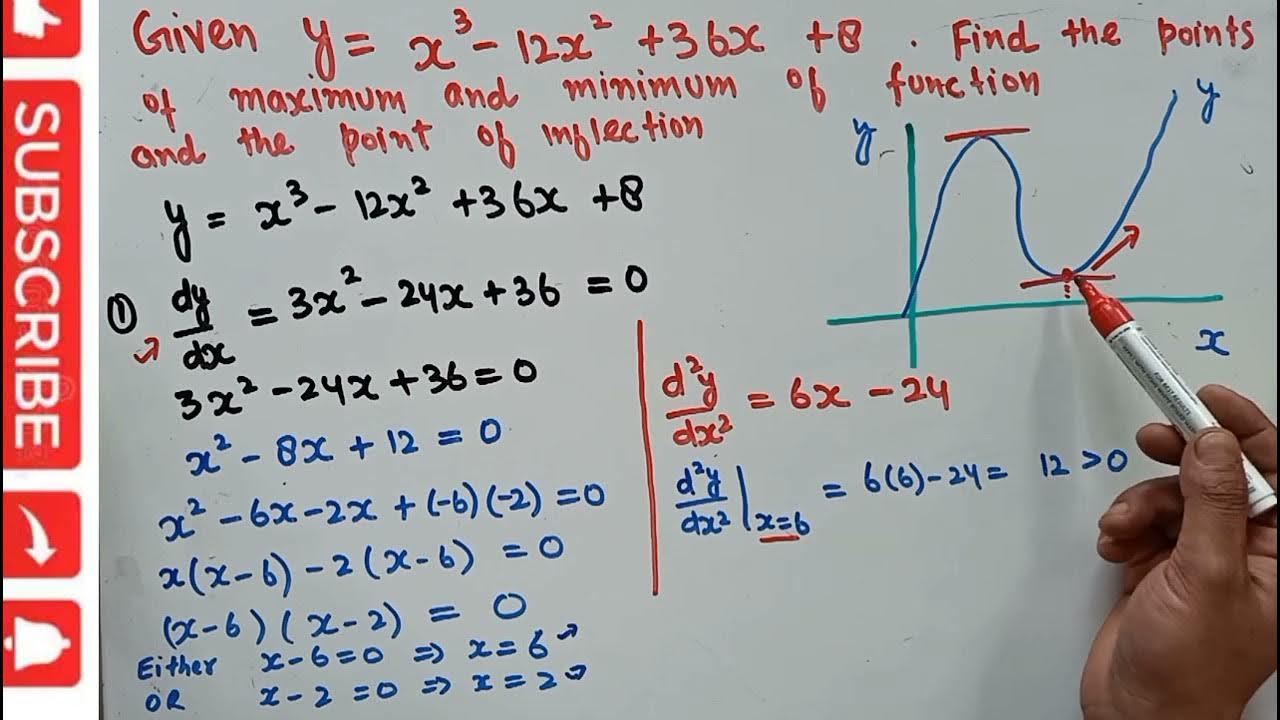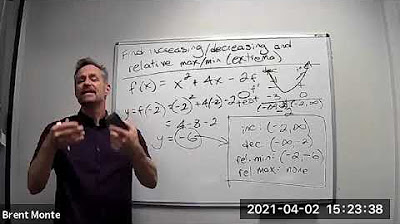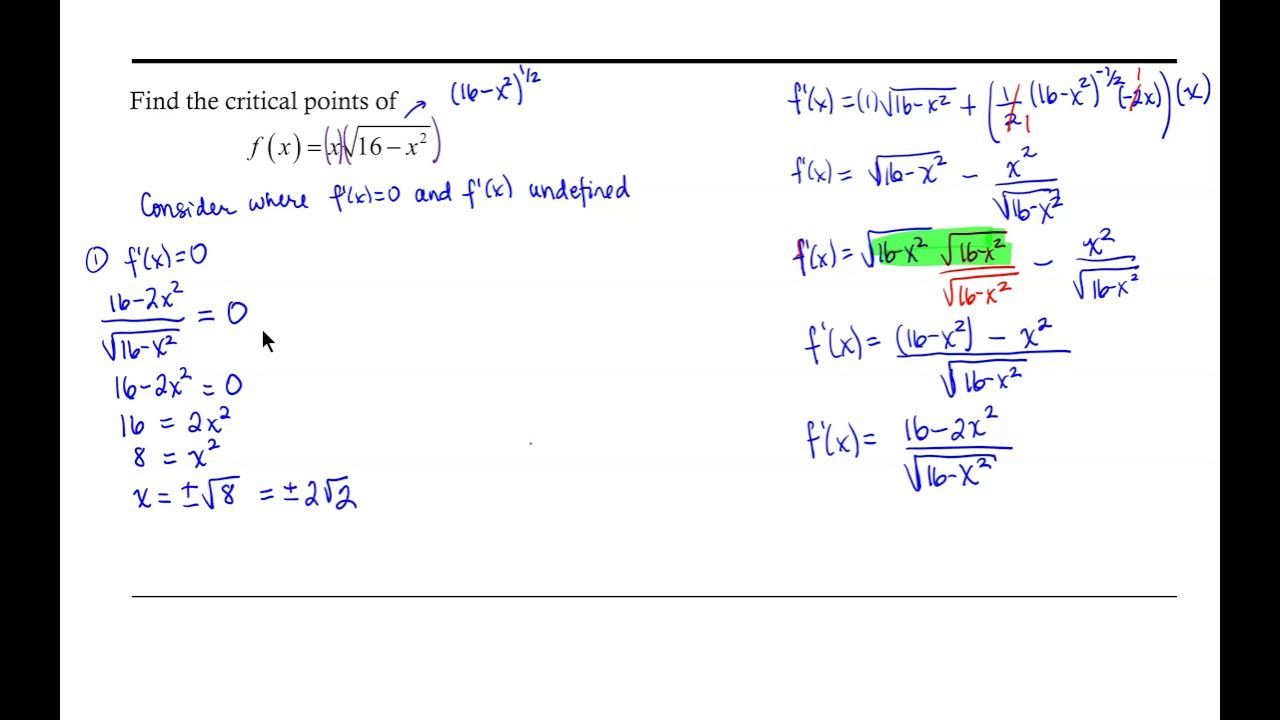Analyzing a function with its derivative | AP Calculus AB | Khan Academy
TLDRThe video script discusses finding minimum and maximum values of a function by identifying critical points. It explains that critical points occur where the derivative is zero or undefined. The function f(x) = x^3 - 12x + 2 is used as an example, and its derivative is calculated. By setting the derivative equal to zero, critical points at x = 2 and x = -2 are found. The video then describes how the sign change of the derivative around these points determines whether they are minimum or maximum values. A graphical representation is used to illustrate the function's behavior, ultimately identifying x = 2 as a minimum and x = -2 as a maximum.
Takeaways
- 📚 The function f(x) = x^3 - 12x + 2 is being analyzed for minimum and maximum values.
- 🔍 To find critical points, the derivative of the function must be found, where it is either zero or undefined.
- 📈 The derivative of the function is found using the power rule: f'(x) = 3x^2 - 12.
- 🎯 Critical points occur where the derivative equals zero, leading to the points x = 2 and x = -2.
- 🔄 The sign change of the derivative around the critical points determines if they are minimum or maximum points.
- 📊 A graph of the derivative shows it crossing the x-axis at the critical points, indicating a change from positive to negative slope at x = -2 and from negative to positive at x = 2.
- 🏁 The function f(x) has a maximum value at x = -2, where the derivative changes from positive to negative.
- 🏁 The function f(x) has a minimum value at x = 2, where the derivative changes from negative to positive.
- 🖌️ A sketch of the function f(x) is made based on the behavior of the derivative and the critical points.
- 📝 The values of f(x) at the critical points are f(-2) = 18 and f(2) = -14, confirming the maximum and minimum values.
Q & A
What is the given function in the script?
-The given function is f(x) = x^3 - 12x + 2.
What are the main goals of the video?
-The main goals are to find the critical points of the function and determine whether they correspond to minimum or maximum values.
How are critical points defined in the context of this video?
-Critical points are defined as points where the derivative of the function is either equal to zero or undefined.
What is the derivative of the given function f(x)?
-The derivative of f(x) is f'(x) = 3x^2 - 12.
How are the critical points found in the video?
-The critical points are found by setting the derivative equal to zero and solving for x, which results in x = -2 and x = 2.
How does the video determine whether a critical point is a minimum or maximum?
-The video determines this by analyzing the sign changes of the derivative around the critical points and graphing the derivative to visually understand its behavior.
What is the significance of the y-intercept in the context of the function f(x)?
-The y-intercept is the point where the graph of the function intersects the y-axis, which occurs when x is zero. For f(x), the y-intercept is at f(0) = 2.
What are the values of the function at the critical points x = -2 and x = 2?
-At x = -2, f(x) = 18 (which is a maximum point), and at x = 2, f(x) = -14 (which is a minimum point).
How does the graph of the derivative help in understanding the behavior of the function?
-The graph of the derivative helps to visualize when the function is increasing or decreasing. Crossing from a positive to a negative derivative indicates a maximum point, while crossing from a negative to a positive derivative indicates a minimum point.
What is the final conclusion about the critical points in the video?
-The final conclusion is that x = 2 is a minimum point and x = -2 is a maximum point for the function f(x).
Outlines
📚 Calculus - Finding Critical Points and Extreme Values
This paragraph introduces the process of identifying critical points and extreme values of a function. The function f(x) = x^3 - 12x + 2 is presented, and the goal is to determine where it has minimum or maximum values. The explanation begins with finding the derivative of the function, which is 3x^2 - 12. The critical points are found by setting the derivative equal to zero, resulting in x = 2 and x = -2. The paragraph then discusses how to determine whether these points are minimum or maximum by examining the sign changes of the derivative around these points. A graphical representation is used to illustrate the concept, ultimately concluding that x = 2 is a minimum and x = -2 is a maximum.
🎨 Sketching the Function and Identifying Extreme Points
In this paragraph, the focus shifts to sketching the graph of the function f(x) based on the previously identified critical points and understanding of the derivative. The y-intercept is established, and the behavior of the function around the critical points is analyzed to sketch the graph. The function is visualized with a maximum point at x = -2 and a minimum point at x = 2. The sketch is not to scale but provides a conceptual understanding of the function's shape and behavior. The paragraph emphasizes the importance of understanding the relationship between the derivative and the function's increasing or decreasing nature to correctly identify extreme points.
Mindmap
Keywords
💡Function
💡Critical Points
💡Derivative
💡Minimum Value
💡Maximum Value
💡Power Rule
💡Constant Rule
💡Slope
💡Graph
💡Y-intercept
💡Sign Change
Highlights
The function f(x) is defined as f(x) = x^3 - 12x + 2.
The aim is to find the minimum or maximum values of the function and its critical points.
Critical points are found by determining where the derivative of the function is zero or undefined.
The derivative of the function is found using the power rule and constant rule, resulting in f'(x) = 3x^2 - 12.
Critical points occur when f'(x) = 0, leading to the equation 3x^2 - 12 = 0.
Solving the derivative equation yields critical points at x = 2 and x = -2.
To determine if the critical points are minimum or maximum, the sign change of the derivative around these points is analyzed.
A graph of the derivative helps to visualize the behavior of the function around critical points.
The function increases to a maximum at x = -2 and then decreases, identifying it as a maximum point.
The function decreases to a minimum at x = 2 and then increases, identifying it as a minimum point.
The graph of the derivative shows a positive to negative slope change at x = -2 and a negative to positive slope change at x = 2.
The function f(x) can be sketched based on the derivative behavior and critical points.
The y-intercept of f(x) is at f(0) = 2.
The function has a maximum value of 18 at x = -2.
The function has a minimum value of -14 at x = 2.
Transcripts
Browse More Related Video

Maxima , minima and point of inflection

Absolute Maximum and Minimum Values - Finding absolute MAX & MIN of Functions - Calculus

Finding Critical Values

Fiding Relative Max, Min and Inflection Point with Derivatives F4

First Derivative Test to find increasing/decreasing and relative max/min

Critical Points: Square Root Function
5.0 / 5 (0 votes)
Thanks for rating: